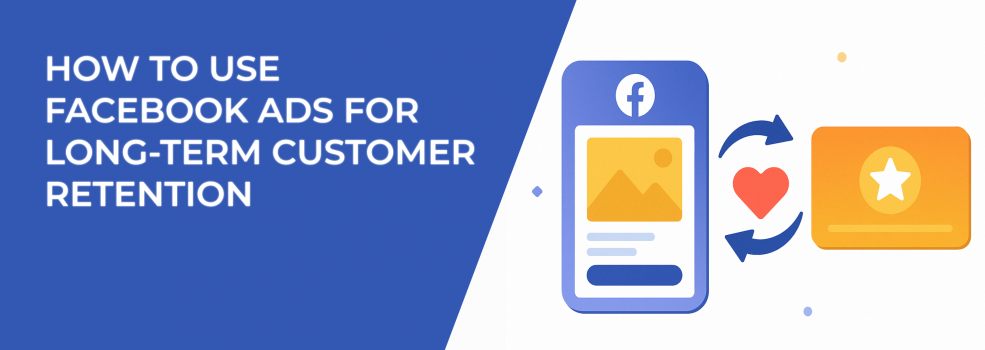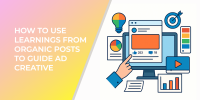Facebook ads are known for their power in driving awareness and conversions. But what about after that first sale? Most advertisers build entire strategies around customer acquisition and then leave their new buyers hanging.
If you're serious about growing a sustainable business, retention can't be an afterthought. In fact, retaining customers is often more profitable than acquiring new ones. Loyal buyers spend more, refer more, and cost less to reach over time.
So how do you use Facebook ads not just to sell but to keep customers coming back?
Let’s dig into the strategy, the tools, and the creative shifts that turn a single sale into a long-term relationship.
1. Know Who You’re Talking To and Segment
Retention starts with relevance. You can’t build loyalty if you're speaking to everyone the same way.
Use Facebook’s Custom Audiences to segment your customer base into meaningful groups. For example:
-
First-time buyers, who need reassurance and onboarding.
-
Repeat buyers, who may be ready for a subscription, bundle, or loyalty reward.
-
High-value customers, who deserve VIP treatment or early access to new products.
-
At-risk customers, who haven’t purchased in a while and may need a reason to re-engage.
Upload your customer data regularly — ideally weekly or biweekly — and refresh your audiences to reflect real behavior. You can also use offline event tracking to sync store purchases, calls, or support interactions with ad visibility.
Strategy tip: create automated workflows outside of Facebook that flag key moments (e.g. 30 days since last purchase) and feed those segments back into Facebook for ad targeting. Treat your Custom Audiences like a CRM, not a static list.
2. Build Smart Post-Purchase Ad Journeys
One of the most overlooked retention opportunities is the post-purchase experience. Most brands stop communicating once the sale is made. But this is the moment when trust is highest — and customers are most receptive.
Here’s a sample 3-phase post-purchase Facebook Ads strategy:
Phase 1: Onboarding and Gratitude (Days 1–7)
-
Thank the customer. Make it personal.
-
Share a video or carousel that explains how to get the most value from the product.
-
Reinforce brand values — remind them why they chose you.
Phase 2: Community and Trust (Days 8–21)
-
Invite them to follow your brand on Instagram or join your Facebook Group.
-
Highlight customer stories or testimonials.
-
Share “pro tips” or creative ways to use the product.
Phase 3: Next Step and Upsell (Days 22–45)
-
Suggest a related product or bundle.
-
Introduce a referral program with a clear incentive.
-
Offer a loyalty signup or milestone-based reward.
Make sure each phase uses custom copy and creative. Don’t retarget buyers with the same product they just purchased — instead, expand their journey.
Strategy tip: use exclusions wisely. Exclude customers from certain campaigns once they move to the next phase. This keeps messaging timely and avoids ad fatigue.
If you haven't already built a solid retargeting system, start here — this guide breaks down how to set up Facebook retargeting for smarter, more relevant follow-up campaigns.
3. Create High-Retention Creative — Not Just Salesy Promos
Retention creative needs to do more than drive a click. It should deepen brand affinity and emotional connection.
Focus on these creative principles:
-
Celebrate the customer, not the product. Use testimonials, review quotes, and user-generated content. Show real people using your product over time.
-
Add value with every view. Share helpful content — not just offers. Quick tips, FAQs, and how-tos build trust and encourage repeat engagement.
-
Humanize your brand. Show behind-the-scenes videos. Introduce team members. Feature your founder telling a story. Personal touches stick.
-
Create “insider” moments. Offer sneak peeks, early access, or loyalty-only announcements. These small touches help customers feel included.
Strategy Tip: Use dynamic product ads (DPAs) not just for cross-selling, but to show accessories, refill items, or customer favorites — based on their past interactions.
Using real customer voices builds lasting credibility. Here’s how to effectively use user-generated content in your Facebook ads without making it feel forced or gimmicky.
4. Use Retargeting Thoughtfully — Timing Matters
Retargeting is the engine behind most retention campaigns, but many brands misuse it by relying on generic “Buy again” ads.
Instead, retarget customers based on where they are in their lifecycle:
-
0–14 Days Since Purchase: Focus on support, how-to content, and social proof.
-
15–30 Days: Re-engage with value adds — product tips, loyalty info, or bundles.
-
31–90 Days: Offer time-sensitive promotions, new releases, or refer-a-friend incentives.
-
90+ Days: Reactivate with win-back campaigns — think flash sales, personalized recommendations, or “We miss you” creative.
Strategy tip: layer in Facebook’s Engagement Custom Audiences (e.g. video viewers, ad clickers) to target customers who interacted with post-purchase content but haven’t bought again. These are your warmest leads for a second conversion.
5. Measure What Actually Matters for Retention
Retention performance won’t always show up in ROAS or last-click conversions. You need to look deeper — at the full customer journey.
Here are key metrics to track:
-
Repeat Purchase Rate — How many customers are coming back within 30, 60, or 90 days?
-
Time Between Purchases — Are you shortening the window between transactions?
-
Retention Ad CTR and Engagement — Are customers clicking, watching, or saving your post-purchase content?
-
Custom Audience Growth — Are your segments (repeat buyers, VIPs, etc.) increasing over time?
-
Customer Lifetime Value (LTV) — Are your ad efforts resulting in more value per customer, not just more customers?
Strategy tip: pair Facebook data with Shopify, Klaviyo, or your CRM to track customer lifecycle metrics. Attribution is messy — but the patterns reveal what’s working.
6. Think Long Game, But Stay Agile
Retention isn't something you "set and forget." Customer needs evolve. Campaigns burn out. What works today might flop tomorrow.
Test constantly — but keep your core strategy focused on consistency, storytelling, and connection. Here are a few agile tactics to try:
-
Rotate creative every 3–4 weeks to avoid fatigue, especially in Custom Audiences.
-
Use A/B testing to compare loyalty messaging, retargeting windows, and testimonial types.
-
Introduce seasonal retention offers (e.g. exclusive bundles for previous buyers).
-
Leverage Facebook’s Advantage+ catalog or audience expansion strategically — but don’t let automation override your segmentation logic.
And above all, listen. What are customers telling you in comments, emails, or support tickets? Retention starts with attention.
If you're running into declining performance from your retention ads, you may be facing ad fatigue. Learn how to spot and fix ad fatigue early before it kills your campaign momentum.
Final Thoughts
If you’re only using Facebook Ads to acquire new customers, you’re leaving money on the table and possibly losing hard-earned buyers in the process.
Retention isn’t flashy. It doesn’t always show immediate ROI. But it compounds.
By combining segmentation, smart creative, lifecycle-based retargeting, and meaningful post-purchase experiences, you can turn Facebook Ads into a retention engine that strengthens your brand from the inside out.
So ask yourself: are you running ads to sell, or are you running ads to build something that lasts?
Your best customers already said yes. What will you do to keep them?

